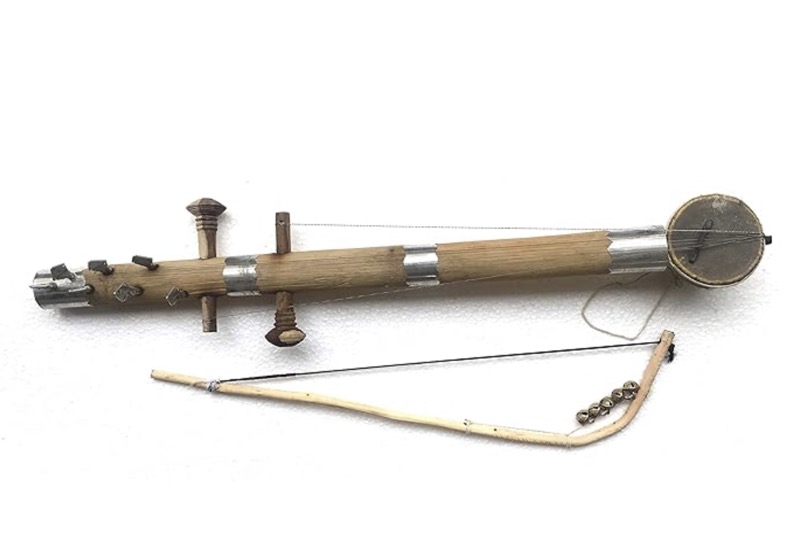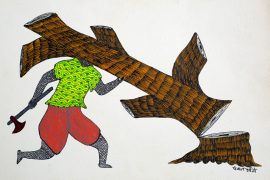Ravanhatta or Ravanstrom, a simple two-stringed bowed instrument, has been a part of India’s ancient history. Today, it is used mainly by bards of nomadic communities of Gujarat and Rajasthan. However, did you know about the debate surrounding Ravanhatta?
Ravanhatta is debated to be one of the oldest stringed instruments played with a bow. While some historians call it a forerunner of the violin, some argue that the first instrument using a bow has Middle Eastern origins.
In 1864, an English solicitor named William Sandys wrote The History of Violin. Almost 50 years later came Violin & its Story by Geoffrey Alwyn. Both Sandys and Alwyn connected the inspiration of bowed instruments to the ancient Ravanhatta of India. ‘Ravanastron,’ writes Alwyn, is ‘the oldest and most widely used instrument of its species in India.”
On the other side was Werner Bachmann, the musicologist who authored the 1969 paper The Origins of Bowing. According to Dr Bachman, the first musical instrument to use a bow originated in Arab regions and Spain, documented after the tenth century AD.
Nanyadeva’s Bharatabhasya of the eleventh Century CE in Bihar mentions Ravanhatta. The Tamil Poetess Ramabhadrambha also records Ravanhatta as an instrument played by women of the Tanjore kingdom. Her works date to the seventeenth century.
Moreover, Bartholomaus Ziegenbalg, a missionary from Germany in the early eighteenth century, also recorded the use of Ravanhatta in Malabar. The name of the instrument, ‘Ravanhatta,’ shares the legend of its origin. It literally means the hand of the demon king, Ravana, the antagonist of Ramayana. Ravanhatta emerged from ‘Ravan Hasta Veena.’
Legend has it that Ravan, an ardent believer in Lord Shiva, showed his devotion via music. He played the veena to please Shiva in fervent recitals. During one of the performances, the instrument began to fall apart. The head broke first, then the soundboard, and eventually the strings.
The lore says Ravan detached one of his many heads to replace the resonator, used his hand as the soundboard, and used veins instead of strings. If Ravan, the infamous king of Sri Lanka, was the creator of Ravanhatta, how did it come to India?
Hanuman is said to have taken the instrument after Ravan was killed.
As phantasmic as the mythical lore sounds, it births the name of the instrument – Ravanhasta or Ravanhatta. No historical records from Sri Lanka suggest the use of a similar musical instrument in the country.
Ravanhatta is a rather simple instrument. The hollow bowl-like resonator of the fiddle is made from coconut shell and goatskin. The Dandi, or the soundboard, is made up of bamboo wood with regular intervals of knobs for tuning. Horsetail hair and steel make up Bajera, the string of the Ravanhatta that produces a ‘weak and dull, though pleasant’ sound, as described by Alwyn. The instrument’s sound can be tuned by changing the tension of the horsehair, just like any stringed instrument.
Ravanhatta may have come to India before the twelfth century, but the instrument never enjoyed royal patronage. It was often seen as the one ‘of the beggars,’ as per Joep Bor, a Music professor at Leiden University and author of Ravanahasta, a Musicological Puzzle. Today, the use of the musical instrument is limited to Bhopas of Gujarat and Rajasthan.
The fiddle-playing minstrels of the two western states of India devote their recitals to Pabuji, the Rabari deity. Pabuji was the community hero who protected the livestock; his stories are performed through songs. Bhopas perform the stories through the night with folk music. Rabaris are the nomadic shepherds who herd camels. They believe Shiva himself assigned them the job of herding sheep.
If you get a chance to witness the instruments of the nomads of West India, you will often observe accessories such as colourful tassels, beads, pouches, chiming bells (ghoongroo), etc. It adds to the charm of the bards or the storyteller but also depicts the ornamental aspect of their culture.
Storytelling bards or the devotees of Pabuji, the Bhopas, narrate the stories at the beat of the music. They do not follow specific rules but practice to keep the rhythm and synchrony.
‘With the age old traditional ceremonies losing their identity, the ritual of story telling on auspicious occasions is fading away. These days, we are left with the option of performing at tourist spots and fairs,’ Shor Ji Bhai Bhopa told Gaatha.
While the use of Ravanhatta has been intertwined in India’s history, it is slowly fading away into oblivion. Soon, the instrument will only remain a topic of debate, and barely any performances will testify to its use in India. However, the homely folk appeal of the instrument has led a few Banjaras to perform at tourist attractions, on TV, and in hotels.
One of the most popular songs played on simple yet melodious Ravanhatta is ‘kesariya balam.’ The song takes every listener to a dry, hot day in Rajasthan or the Rann of Kutch as Bhopa strings along his mournful Ravanhatta.
-30-
Copyright©Madras Courier, All Rights Reserved. You may share using our article tools. Please don't cut articles from madrascourier.com and redistribute by email, post to the web, mobile phone or social media.Please send in your feed back and comments to [email protected]











